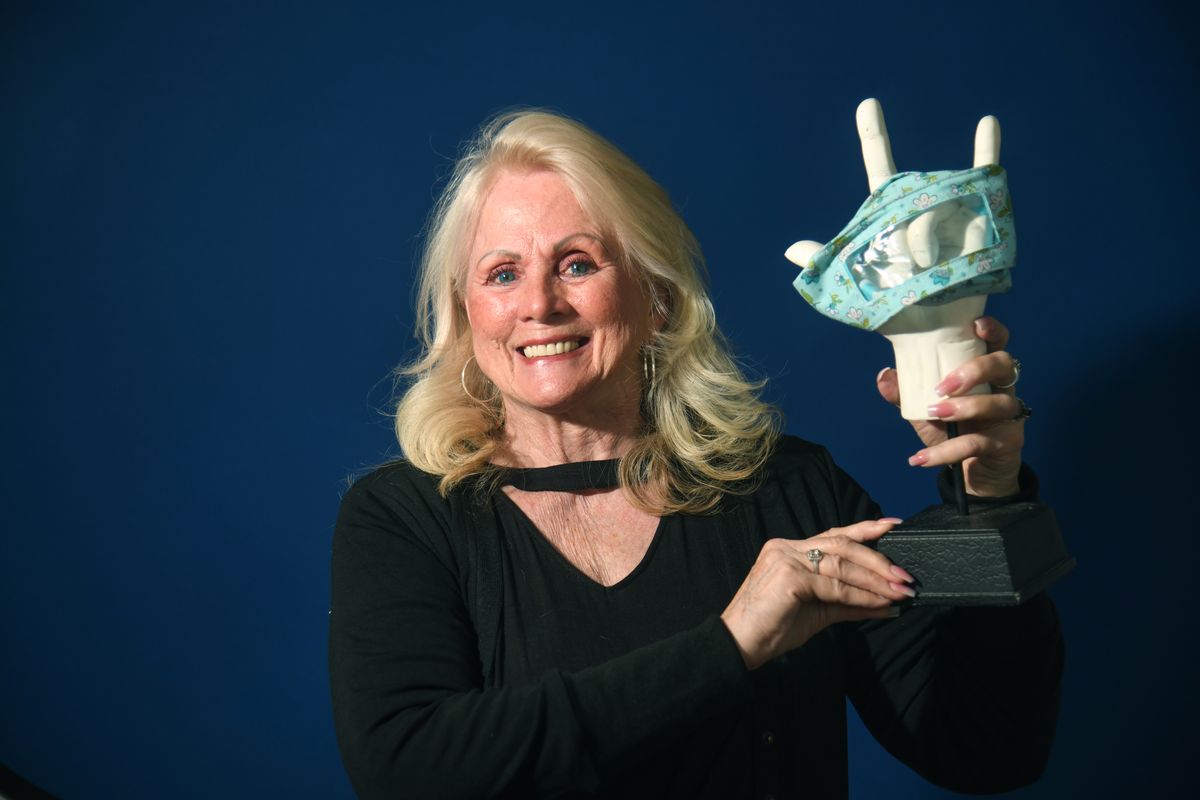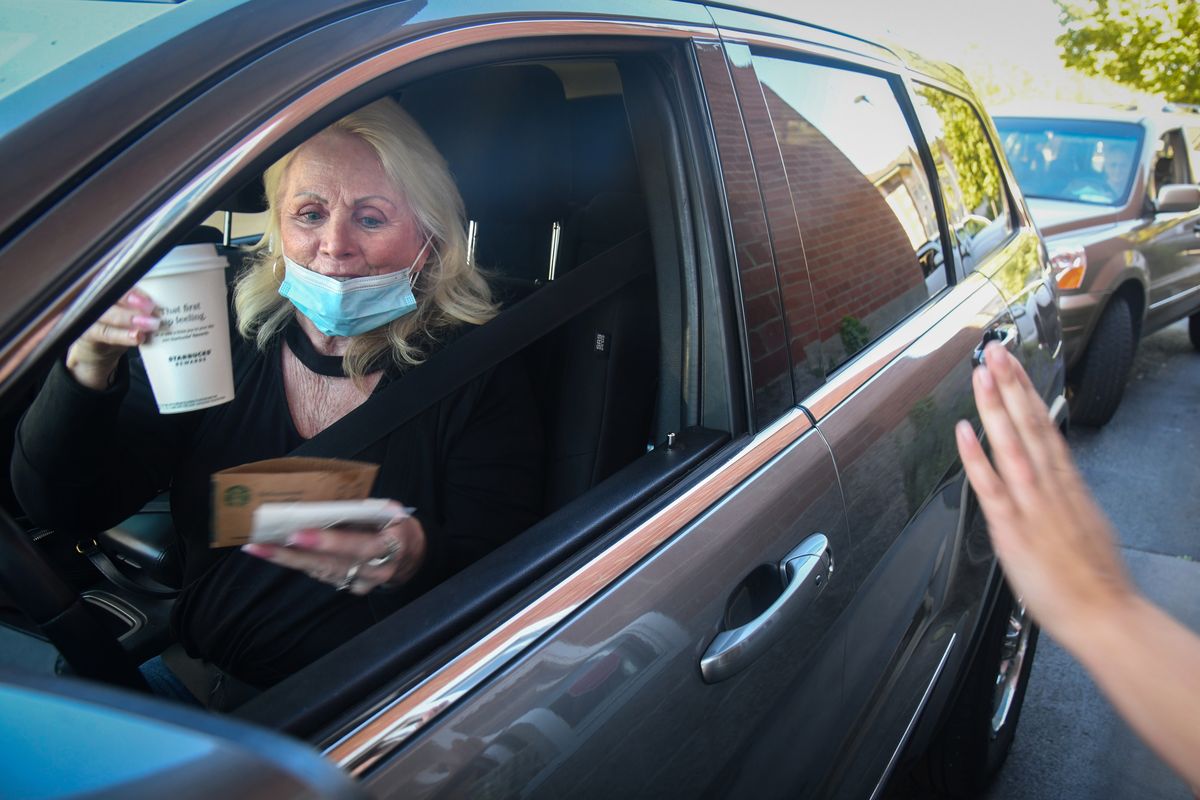Making it crystal clear: Face masks add barriers in communication for the deaf and hard of hearing
Sandra Carr, who is hearing-impaired, displays a hand signing “I love you” and sporting a face mask with a clear window at her Spokane Valley office on Friday. (Dan Pelle/The Spokesman-Review)Buy a print of this photo
When Sandra Carr gets coffee in a drive-thru, many baristas working at the window will drop a mask to the chin so she can understand them. That’s because Carr is hearing-impaired.
In these moments, Carr keeps her mask on or remains physically distanced. But she knows in other public places, it’s a challenge for deaf or hard-of-hearing people to understand communication behind masks. Some people are helping by wearing face coverings with clear material over the mouth or clear face shields, she said.
Carr works as an advocate in Spokane with Washington Advocates of Deaf & Hard of Hearing. She said under a July 24 updated state order amending face covering rules, people can temporarily pull down a mask in public for certain situations, including when it’s essential to communicate with a deaf or hard-of-hearing individual. While she supports masks for public health, Carr is well aware of continuing challenges for the deaf community.
“It’s been very frustrating to say the least because I’m a deaf person myself,” she said. “You have to remember, deaf people really concentrate on the person’s facial expressions as well as sign language when they’re talking to someone else.”
“For example, I’m talking to you right now in a normal voice, but if I were to change my voice to something a little bit more angry or excited, you could hear the change in my voice. Also, my facial expression might match that. Because deaf people don’t hear the voice, they concentrate very much on the facial expressions that go along with the signage, but because of masks that do not have clear windows, that has become difficult for deaf people.”
The Washington State Department of Health recognizes the issue. Its June 8 blog covers how important “non-verbals” are in communication: a smile, gentle touch, leaning to whisper. It’s frustrating for all, the blog says, “but so much more so for those of us who are deaf or hard of hearing and routinely read lips and facial expressions to communicate.”
In her job, Carr said deaf and hearing-impaired people locally are asking for support. In one example, she assisted someone working at a big-box store in Spokane who was part of staff meetings talking about COVID-19. However, Carr said the other people in the meetings didn’t provide a way for the deaf person to understand the communications such as members wearing a mask with clear material for lip reading or offering a sign-language interpreter.
“This was important, and the big-box store was not willing to accommodate,” Carr said. “Our agency is trying to educate people in stores and other public places regarding masks and the deaf community and making accommodations. As an advocate, I’d like the public to be aware there are deaf people and that we need to be a little bit humble to try to find ways to communicate with deaf people.
“Clear masks and shields are becoming more widespread. We do need to follow COVID protocols – wash hands … don’t touch your face – just remember the deaf and hard-of-hearing are people, too.”
During her early years, Carr grew up as a hearing person and then became deaf as she got older due to a childhood illness.
“I took advantage of total communication, which means lip reading, facial expressions, hearing aid, then cochlear (implant) and sign language,” Carr said. “I incorporated the whole spectrum for a person who is deaf. Not everyone does that. We have a lot of deaf people who don’t read lips at all; they just sign, but they still are missing the facial expressions if you don’t have a window.”
Although she eventually got the cochlear implant that enables some hearing, it isn’t the same as if she were a hearing person, she said.
“If I’m out in public and see people with a mask, it just kind of makes me feel deafer because I’m missing that facial part of my communications; I can’t see people’s expressions,” Carr said. “More and more people are making masks at home with a clear window so people can see you talking. That also depends on whether it’s a good window.”
Here are some state Health Department tips for the deaf and hard of hearing:
• Consider smartphone apps to help with speech-to-text or sound-amplifying capabilities. Carr is said she’s aware of a free Android app, Live Transcribe. Others are MyEar, a fee-based app available for i- Phones or iPads, and Ava, a live transcribing app for Android or Apple products with a certain number of hours per month free.
• Carry pen and paper and ask people to write down what they are trying to say.
• Try different masks if you wear hearing aids – a cloth face covering that ties in the back might be better versus one that loops around your ears.
• Ask an audiologist if adjustments can be made to your hearing aids to help you more clearly hear speech muffled by cloth face coverings.
The department also offered ideas for people who aren’t deaf or hard of hearing:
• Use extra patience in communicating. It’s frustrating for all when we don’t understand or someone misinterprets what we mean.
• Try more gestures even if you don’t use actual ASL signs: pointing, a wave to get attention, a shrug or even an eye roll.
• Consider making a face covering that allows others to see your lips as you speak. Here are some online instructions at hsdc.org/accessible-deaf-friendly-face-mask/.
For public services or professional appointments, Carr said her agency encourages the use of certified sign-language interpreters if needed, but she added that because of COVID-19, interpreters might be more cautious about interpreting in a public setting.
She hopes people become more aware of the July 24 state order updating when individuals may remove their face coverings in public, including: “When any party to a communication is deaf or hard of hearing, and not wearing a face covering is essential to communication.”
“The deaf person has a right to ask you to drop a mask down temporarily to understand you,” Carr said.
“Our agency is trying to educate people in stores and other public places regarding masks and the deaf community and making accommodations.”

